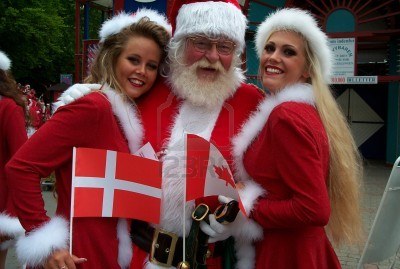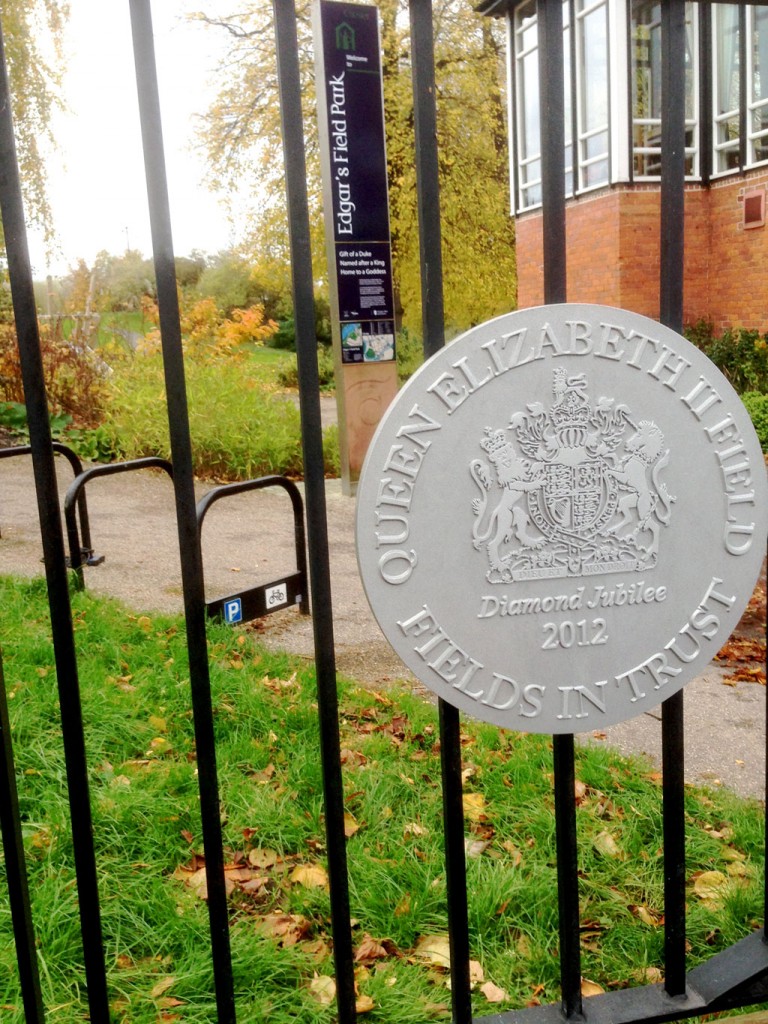
* So, 37 days to Christmas then. I’ve delved back in the archive on a Christmas theme for an early freelance story from Copenhagen. Follow me on Twitter, or subscribe to the RSS, for more update.
* Photo via AP.
Paradise Yamamoto is running late.
He’s got jetlag having just come off a plane from Japan, a rip in the pants of his Santa suit and one of his bongos is missing.
But there’s no time to worry now. It’s 9am on a sunny July morning in Copenhagen and the official opening ceremony of the 39th annual World Santa Claus Congress is about to get underway.
Back home in Tokyo, Paradise-san lives a double life.
Not only is he an accomplished bongo player with his own Latin club nights and CD back catalogue, but he has quickly risen through the ranks to become Japan’s leading – indeed only – mambo Santa.
Today he will be flying the flag for Japanese Santa power while bashing out a Latin rhythm with the assistance of his trusty helper, Rudolph-san, dressed specially for the occasion in a fetching crotch-hugging jump suit and tinsel ears.
“OK,” he beams, securing his stick-on beard, “let’s mambo. Ho ho ho.”
Summer summit
While in Britain we bemoan the arrival of Christmas lights and grottos hot on the heels of Bonfire Night, the spirit of Christmas comes especially early each year to Bakken, an Art Deco amusement park north of downtown Copenhagen – exactly six months before Santa’s big day to be precise.
This uniquely festive gathering made its debut in 1963 as a slightly incongruous one-off event in Bakken with Santas from across Denmark coming together to play games, swap ideas and kick off the countdown to Christmas against a backdrop of green fields and sunny skies.
It proved such a success that organisers made it an annual event. Today the Santa Claus Congress is a truly global event.
Over 120 bone fide genuine Santas from countries as diverse as Greenland, Venezuela and the Congo (this year, Great Britain was conspicuous by its absence) come together for a three-day festive get-together that is part corporate bonding session, part harmless – albeit slightly surreal – fun.
“The Santas are too busy to met up and talk shop in the run-up to Christmas itself.”
“This event allows them to raise the burning issues and resolve conflicts before the Christmas rush,” dead-pans Tina Baungaard, one of the event’s organisers.
As I watch the assorted Santas, Mother Christmases and token elves registering for their name badges, I learn from Tina that Santa Congress has a serious agenda like any other trade fair or conference.
Amongst the topics for discussion at this year’s talking shop are EU moves to standardise Santa footwear sizes, concerns that hard-working reindeer are increasingly hard to come by and fears that false beards are spoiling the good name of Father Christmas.
The year’s burning issue, however, is a motion tabled by the Spanish contingent to have Christmas Eve moved to January 6.
The Scandinavian Santas, who celebrate December 24 as the main day of Christmas with presents at midnight and a large family meal, are said to be incandescent with rage at the prospect. At least, the ones whose faces I can see under a mountain of greying facial hair appear to be.
The formalities and introductions dispensed with, the Santas are gathered together on a makeshift stage overlooking the park’s fast food stands to break the ice with some Santa tai chi exercises.
I find myself standing next to a man flipping hot dogs in a burger van who looks as if the sight of around 100 middle-aged men in red fluffy suits and fake beards exposing copious amounts of bum cleavage is an everyday occurrence in the Danish countryside.
For me, however, such a wanton display middle-aged spread puts me right off breakfast and leaves me pondering ‘who ate all the mince pies.’
Serious talk
After a spot of dancing round the Christmas tree, we form an orderly procession and, led by a troupe of what can only be described as Santa bunny girls whose costumes set some of the old codgers hearts perilously racing, we head down to Bellevue Beach for another annual congress tradition: Santa paddling.
En route, I get talking to Toshi Kawanuma from Japan who describes himself as Inamoto Santa in homage to the Japan World Cup star and is making his debut at this year’s event.
According to Toshi, behind the smiles and talk of goodwill to all men, professional rivalries and jealousies run rife in the backstage area with Santas jostling for the position of Santa of Honour. It is, prsumably, like being backstage at a Milan catwalk show – except with fewer eating disorders and bigger knickers.
“I feel I have to prove myself as I’m new here,” says Toshi, rubbing his stubbly upper lip.
“That’s why I bleached my moustache white – to show them I’m serious about being a proper Santa.”
“It really hurt,” he adds despondently.
Back among the inner circle of anointed Santas, however, the mood is ebullient.
Indeed, by the end of the first day, the good people of Copenhagen have been subjected to semi-naked Santas bathing, a procession of Santas running riot along Stroget (the main pedestrian shopping street) and a pre-Xmas open air concert in Town Hall Square complete with carol singing and generous helpings of ho-ho-hos.
For even a Christmas cynic like myself, the infectious atmosphere has me fighting an overwhelming urge to rush out and deck the halls with bales of holly.
Christmas cheer
But before I leave the Santas to their serious discussions to be conducted behind closed doors, we all have one last appointment – a Christmas dinner in the town hall hosted by Bente Frost, deputy leader of Copenhagen City Council.
As the Santas hang up their suits and make a beeline for the turkey drumsticks, I go to take a picture of one Santa in civvies talking on his mobile phone.
“No pictures,” he snaps at me, “we’re off duty now.”
And a very merry Christmas to you too.
* This story first appeared in The Big Issue in 2002. Liked this? Try The Holy Grail of Hotdogs in Copenhagen.
Post your comments below.





